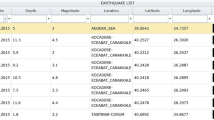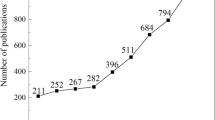Abstract
A significant proportion of the urban areas in Turkey is subject to high seismic risk. An important step for seismic risk mitigation is to define the hazard and damage after an earthquake. This paper proposes an integrated seismic hazard assessment and disaster management processes for Turkey. The proposed methodology utilizes information technologies in its seismic assessment component that provides fast results for assessment. First, image process methodology by using satellite images was implemented in the seismic assessment process for fast evaluation right after an earthquake. Second, the seismic assessment process was integrated with disaster management process. As a result, through integrated seismic hazard evaluation and disaster management procedure, an effective, fast and dependable estimation of loss for Turkey was planned.















Similar content being viewed by others
References
Belazougui M, Farsi M, Remas A (2004) Seismic risk assessment of current buildings of Algiers city. Paper presented at 13th world conference on earthquake engineering, Vancouver, Canada, 4–6 August 2004
Bruneau M (2002) Building damage from the Marmara, Turkey earthquake of August 17, 1999. J Seismol 6:357–377
EERI (1986) Reducing earthquake hazards, lessons learned from earthquakes. San Francisco, CA, USA
Ellul F, D’ayala D (2003) The Bingöl, Turkey Earthquake of the 1st of May 2003. Field report, Earthquake Engineering Field Investigation Team EEFIT, Architectural and Civil Engineering Dept., Univ. of Bath, Bath, UK
Erdik M, Demircioglu M, Sesetyan K, Durukal E, Siyahi B (2004) Earthquake hazard in Marmara Region, Turkey. Soil Dyn Earthq Eng 24:605–631
FEMA (1999) HAZUS 99, Estimated annualized earthquake losses for the United States. FEMA 366, Washington DC, USA
Gastner MT, Newman MEJ (2004) Diffusion-based method for producing density equalizing maps. Proc Natl Acad Sci USA 101:7499–7504
GDMA, General Directorate of Minister Affairs (2009) Earthquake Research Department
Google Earth (2009) Satellite Image web page. http://maps.google.com
Griffiths JHP, Irfanoglu A, Pujo S (2007) Istanbul at the threshold: an evaluation of the seismic risk in Istanbul. Earthq Spectra 23(1):63–75
Gülkan P (2000) Building code enforcement prospects: failure of public policy, Chapter 15 of 1999 Kocaeli, Turkey, Earthquake Reconnaissance Report. Earthq Spectra 16(A) 351–367
Gülkan P (2005) An Analysis of risk mitigation considerations in regional reconstruction in Turkey: the missing link. Mitigation and Adaptation Strategies for Global Change 10:525–540
Gülkan P, Ascheim M, Spence R (2002) Reinforced concrete frame building with masonry infills. WHE Report 64 (Turkey), World Housing Encyclopedia Earthquake Engineering Research Institute and International Association for Earthquake Engineering web page (http://www.worldhousing.net)
Hashitera S, Maki N, Hayashi H (1999) The potential of using satellite images to determine an index of recovery from natural disaster: a case study of the great Hanshin-Awaji Earthquake Disaster. 6th Japan/United States workshop on urban earthquake hazard reduction
Hayashi H, Yamazaki F, Maki N, Matsuoka M, Hashitera S, Kohiyama M (1999) Estimated damage area in the 1999 Kocaeli Earthquake—Turkey based on the nighttime satellite images
Inel M, Ozmen H, Bilgin H (2008) Re-evaluation of building damage during recent earthquakes in Turkey. Eng Struct 30:412–427
Irtem E, Turker K, Hagul U (2007) Causes of collapse and damage to low-rise RC buildings in recent Turkish earthquakes. J Perform Constructed Facil 21(5):351–360
Korkmaz KA (2009) Earthquake disaster risk assessment and evaluation for Turkey. Environ Geol 57:307–320
Kotil E, Konur F, Ozgur H (2007) The economic impacts of gulf earthquake. International Kocaeli Earthquake Symposium, Kocaeli, Turkey, 22–26 Oct, 2007
Mitomi H, Yamazaki F, Matsuoka M (2000) Automated detection of building damage due to recent earthquakes using aerial television images. The 21st Asian conference on remote sensing, pp 401–406
Mitomi H, Matsuoka M, Yamazaki F (2002) Application of automated damage detection of buildings due to earthquakes by panchromatic television images. The 7th US national conference on earthquake engineering
Mizutani T (2002) Science and technology for natural disaster prevention. University of Tokyo Press, Tokyo
Olson DL, Wu D (2008) Enterprise risk management. World Scientific Publishing Company, Singapore
Özcebe G (2002) Structural damages and reasons observed in 3 February 2002 Afyon-Sultandağı earthquake. Civil Engineering Dept., Middle East Technical Univ., Structural Engineering Research Unit
Özcebe G, Ramirez J, Wasti ST, Aykut A (2004) 1 May 2003 Bingöl earthquake engineering report. Rep. No. 2004/1, TÜBİTAK SERU Structural Engineering Research Unit, Ankara, Turkey
Öztürk S, Bayrak Y, Çınar H, Koravos G, Tsapanos T (2007) Regional variations of earthquake hazard parameters for different source regions in Turkey and vicinity. International Kocaeli earthquake symposium
Queensland Government (2009) State Disaster Management Group, http://www.disaster.qld.gov.au
Sahin M, Ucar D, Tari E, Ipbuker C (2005) Disaster information system of Turkey (TABIS): GIS standards, HAZTURK, Strategies for an earthquake loss estimation program for Turkey, Istanbul, Turkey
Sarker JK, Ansary MA, Rahman MS, Safiullah AMM (2009) Seismic hazard assessment for Mymensingh, Bangladesh. Environ Earth Sci (online)
Scawthorn C, Johnson GS (2000) Preliminary report Kocaeli Izmit earthquake of 17 August 1999. Eng Struct 22(7):727–745
Schneider P, Schauer B (2005) An earthquake risk assessment tool for Turkey. HAZTURK Strategies for earthquake loss estimation program for Turkey, Istanbul, Turkey
Schneiderbauer S (2007) Risk and Vulnerability to natural disasters—from broad view to focused perspective, PhD thesis, University Berlin, 102 p
Sucuoğlu H (2000) The 1999 Kocaeli and Düzce—Turkey earthquakes. Middle East Technical University
Sucuoğlu H, Yazgan U (2003) Seismic risk assessment survey of urban buildings. The role of local governments in reducing the risk of disasters. World Bank Institute, Istanbul, pp 127–147
Taubenböck H, Roth A, Dech S (2007) Vulnerability assessment using remote sensing: the earthquake prone mega-city Istanbul, Turkey. International symposium on remote sensing on environment (ISRSE, 2007), San Jose, Costa Rica, pp 5, (25/6/2007–29/6/2007)
TUIK, Turkish Statistical Institute (2009). http://www.tuik.gov.tr
Turkish Earthquake Site (2009). http://www.sayisalgrafik.com.tr/deprem/
Wei J, Zhao D, Wu D, Lv S (2009) Web information and social impacts of disasters in China. Hum Ecol Risk Assess 15:281–297
Worldmapper (2009) Worldmapper gridded population cartograms. http://www.worldmapper.org/
Wu D, Olson DL (2008) Earthquakes and risk management. 2008 International conference on risk management & engineering management
Zlatanova S, Fabbri AG (2009) Geo-ICT for risk and disaster management. Importance of Geo-ICT in risk and disaster management, GeoJournal Library, geospatial technology and the role of location in science
Author information
Authors and Affiliations
Corresponding author
Rights and permissions
About this article
Cite this article
Korkmaz, K.A. Integrated seismic hazard evaluation and disaster management approach for Turkey. Environ Earth Sci 61, 467–476 (2010). https://doi.org/10.1007/s12665-009-0358-0
Received:
Accepted:
Published:
Issue Date:
DOI: https://doi.org/10.1007/s12665-009-0358-0




